Abstract
Two different types of primary sewage sludge have been used as feedstock for production of biogas through anaerobic digestion (AD): the one type was sludge from a typical primary clarifier (PC), while the other type of sludge produced by a rotating belt filter, commonly called microsieve (MS). Initially the main physicochemical characteristics of the sludges, such as total solids (TS), volatile solids (VS), VS/TS, pH and carbon to nitrogen ratio (C/N) were determined, for MS: 37.86 ± 0.08%, 83.00 ± 0.41%, 0.83 ± 0.00, 6.67 ± 0.08 and 19.68 ± 0.69, respectively, and for PC: 2.61 ± 0.08%, 78.77 ± 1.91%, 0.79 ± 0.02, 6.61 ± 0.10 and 14.46 ± 1.23, respectively. Then, calculated amounts of the sludges were inserted into airtight vials and were inoculated using anaerobic sludge. The daily biogas production was measured over a period of 30 days. PC sludge maximized the daily biogas production (44.20 mlbiogas/gvsd) 11 days after inoculation, while the MS sludge reach a peak (37.74 mlbiogas/gvsd) 14 days after inoculation. The cumulative biogas production over the 30 days of AD was in the same laver (442.29 mlbiogas/gvs for PC versus 434.73 mlbiogas/gvs for MS). However, PC sludge indicated higher daily biogas production, compared to MS sludge, while the opposite was observed for the period following the peak point. The Volatile Solids Reduction for PC and MS sludges was recorded as 46.06% and 32.39%, respectively.
1. Introduction
Wastewater treatment plants (WWTPs) have been developed to treat wastewater to the desired standards, prior to discharge into the receiving environment. Biosolids, commonly referred as municipal sludge or simply sludge, is a nuisance by-product of wastewater treatment process. However, sludge may be used as a resource material to produce energy, fertilizers, and other valuable products. On the one hand, it is mostly laden with pathogens and heavy metals, and in that case, it requires stabilization before it can be further utilized. Due to the stringent laws associated with environmental protection from waste, and in this case wastewater, efforts have been targeted at finding novel and more efficient ways of meeting these requirements [1]. On the other hand, WWTPs consume electrical energy during the process of treatment and due to the indefinite depletion of fossil fuel reserves, a lot of focus and effort has been placed on coming up with alternative renewable energy sources to help alleviate strain on the main source. In essence, the energy content of influent sewage is generally at par with if not more than the energy required for its treatment. Therefore, through the biological process of anaerobic digestion (AD) of sludge, it is well documented that not only environmental pollution can be controlled, but there is also enormous potential for energy recovery [2], which may be enough even for the operation of energy self-sufficient WWTPs [3].
Aeration in the biological treatment units of the process has particularly been noted to be an energy intensive process [4]. Enhancement of the treatment process at early treatment stages, more specifically the primary stage, has shown positive results in improving physicochemical properties downstream of the wastewater treatment process therefore leading to reduced energy requirements by the subsequent stages in this process [5]. The introduction of a microsieving (MS) process, upfront of the aeration tank, results in to a significant increase in overall wastewater treatment efficiency. Microsieving does not only excessively removes solids, but it also produces biosolids with exceptionally high solid content, reaching solid concentrations beyond 40%. For comparison purposes, conventional primary clarification (PC) usually produces sludge with solid contents between 3–6%, while after thickening and dewatering using coagulants the solid content may reach up to 20%, at best [6], as shown in Table 1, which shows an average solids concentration of 19.5% at Chania WWTP as compared to 15% at Rethymno WWTP. Meanwhile with the use of MS technology the same activity is a one step process that produces a higher solids concentration above 40% and, therefore, proves to be more advantageous in terms of time, energy, required space and raw materials requirement.

Table 1.
Characteristics of sewage sludge from Chania and Rethymno WWTPs [6].
Previous research work has further observed PC and MS technology to have relatively similar BOD reduction of about 25–40%, which by current global standards is fair, and even though that is the case, PC imposes a significantly large facilities footprint of about 20 times that of MS given the same hydraulic capacity [7], which in that regard gives the latter an advantage of ease of future facilities expansion. To elaborate more on this comparison of both technologies in terms of size, there is also an issue of population growth, which according to [8] is expected to grow by at least 60% in three decades, which will have a direct influence on the operation of WWTPs in terms of their efficiency as well as the inevitable need for facilities expansion. Therefore, compact innovations such as MS that perform rather similar roles as conventional technologies are welcomed developments. The upfront removal of solids (i.e., sludge) as a mechanism employed by MS may also be seen as a means to help alleviate the problem of over dispositioning of sludge as can sometimes be seen in some WWTPs. For example, the performance efficiency in several WWTPs in the country of Botswana would be significantly increased by the introduction of the MS process upfront of the aeration tank [9].
This study is basically a comparative analysis between conventional primary clarification process and a relatively new process for the removal of solids in wastewater management. This comparison was largely based on the quality of sludge that each technology produced and most importantly on the potential for biogas production from sludge. Furthermore, the process of sludge digestion helps ease its disposal and therefore WWTPs are ultimately able to operate within allowable waste disposal limits. This study will therefore make valuable contributions towards the energy industry, most specifically the renewable energy sector as the global community transitioning from fossil fuels to renewable fuels.
Moreover, the present study provides a sustainable alternative process for the valorization of a nuisance byproduct, such as sludge, with parallel improvement of WWTP performance. The primary advantage of the novel process (MS) is that it can be used for upgrading the perforate of WWTPs at significantly reduced space, as it requires less than 5% of the area that would occupy a PC, while the capital and operational costs are also reduced. The main product, biogas, may be used by the industry as energy source, while the processed sludge is converted to a stabilized organic product, which may be used as prime material for the production of compost.
To the knowledge of the authors this is the first study on direct comparison of the biogas production potential between PC and MS sludges. Both type of sludges has been produced from industrial scale alienations, using real municipal wastewater. A detailed physicochemical analysis of both sludges has been performed; thus, the present study is one of the first studies to present the comparison of MS sludge.
2. Materials and Methods
2.1. Study Area
The area for which this study was conducted in was the Greek island of Crete, which has a total permanent population of around 600,000 people [10]. The WWTPs from which this study was conducted were in Chania city (population about 100,000), which is on the northwestern part of the island (35.5138° N, 24.0180° E), as well as the WWTP in Rethymno city (population about 55,000), which is located on the northern part of the Island (35.3644° N, 24.4822° E).
The Environmental Processes Design Laboratory of the School of Chemical and Environmental Engineering, Technical University of Crete, has placed a MS (by M2 Renewables, Inc., Minato City, Tokyo, Japan) at the WWTP in Rethymno, a treatment system that uses extended aeration, and therefore does not employ primary clarification. This device was placed in a position conventionally like that of a PC unit, i.e., between the preliminary treatment processes and the aeration basins. The MS unit was not part of the overall treatment system, but rather was a bypass and was only in use whenever observations were made, or samples taken. The Micro-Sieve (Figure 1) uses a rotary 350 μm polyester cloth that filters wastewater that is pumped into it after passing the headworks stage (screening and degritting). The fabric belt filter adjusts its rotation according to the flow rate of wastewater as it enters the device, and the accumulated grit or filtrate is then deposited into a trough. As the cloth belt filter moves there is a wet scrubber that washes off the filtrate into a collection trough. A slow-moving auger screw gently moves this collected sludge towards an exit where it is dewatered. The MS sludge samples had been collected from the unit as auger exit.
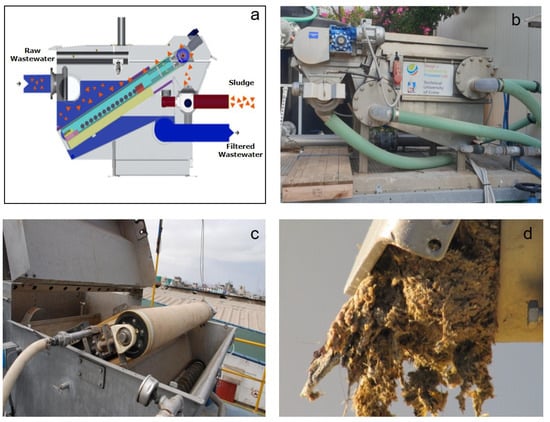
Figure 1.
(a) Schematic diagram of rotary belt filter (microsieve), (b) photograph of microsieve used for MS sludge production, (c) fabric belt and auger in microsieve, and (d) MS sludge exiting the microsieve.
The WWTP in the municipality of Chania, uses a conventional activated sludge system with a PC, from which the sludge samples had been collected.
2.2. Sample Collection and Analyses
Sludge samples were collected and refrigerated in preparation for further analyses, but before storage various physicochemical properties were measured.
- TS and VS
The sludge was weighed using an analytical balance (Oxford A2204, ±0.0001 g) and then put in a drying oven (Memmert U10) set at a temperature of 105 °C. After 24 h, the samples were weighed then transferred into an oven (Filli Galli G. & P. muffle furnace) set at a temperature of 660 °C for another 24 h and the ash content was waited. The results were then used for calculating the TS and VS content of the sludge.
- pH
MS sludge was moist solid mixture, therefore it required dilution with de-ionized water to extract a solution for measuring the pH. A sample of 5 g of the sludge was mixed with 25 mL of de-ionized water in a 50 mL polyethylene bottle and fitted airtight with a cap before being put in a centrifuge (Hettich Rotofix 32 A) set at 4000 rpm for a duration of 10 min. From the centrifuge they were put in a mechanical shaker for another 60 min. The samples were then measured for pH [(alpha-800 pH/ORP Controller & Transmitter c/w process electrode) (temp—±0.5 °C), (ORP—±1 mV), (pH—±0.01)]. On the other hand, PC samples did not require the same process for testing pH, as they were already in liquid form.
- C/N
A different set of sludge samples, for both MS and PC, were also taken and weighed (Oxford A2204, ±0.0001 g) before being dried in an oven (Memmert U10) set at 105 °C for 24 h, after which they were crushed to powder with a mortar and pestle. The powder was then weighed in aluminum foils using a Sartorius digital precision scale, after which they were analyzed for Carbon and Nitrogen content in a CHNS-O elemental analyzer (EuroEA3000).
2.3. Experimental Procedure
On the day of batch reactions preparation, a live inoculum was collected from the outlet of the municipal sludge anaerobic digester, operating in Chania WWTP. The sample was stored inside a heating and drying Oven (Heraeus Series 6000) manufactured by Thermo Scientific, at 37.2 °C (310.35 K) for up to 2 h. The TS concentration of raw PC and MS sludge samples differ significantly, having average values of about 2.61% and 37.86%, respectively, thus, calculated amounts of deionized water were added in the MS sludge samples, to achieve similar TS concentrations for all samples.
A series of batch anaerobic digestion trials at substrate ratios (Ri/s) of 0.45, 1.0 and 2.8 were carried out, to estimate the optimum ratio for biogas production. The most beneficial Ri/s of the ones tried was 0.45, thus all trails took place at the above ratio. Thus, for each batch anaerobic digestion trail, 200 g of substrate were mixed with 100 g of inoculum. In order to achieve a TS concentration of 2.61% for MS sludge, 13.79 g of MS sludge was mixed with 186.21 g of deionized water for each anaerobic digestion batch trial based on Equation (1).
- Cms—TS concentration of MS sample;
- Mms—Mass of MS sample;
- Cpc—TS concentration of PC sample;
- Mpc—Mass of PC sample.
The batch reactions were prepared in 1000 mL borosilicate glass vials (IsoLAB Germany) that were fitted airtightly with 10 mm mini lever gas ball valves for easy and efficient measuring of the biogas produced. They were thoroughly cleaned before use and subjected to a vulnerability test as an assurance of their airtightness. The sludge was measured and weighed, and MS sludge was prepared according to the procedure described above. Before inoculation they were all placed inside a drying oven (Heraeus Series 6000) set at 37.2 °C for a period of 2 h to allow them to attain the same temperature as the inoculum, as shown in Figure 2. After the inoculation process the vials were filled with Argon gas (Ar) in order to eliminate oxygen and ensure anaerobic conditions, and were finally incubated in the oven (Heraeus Series 6000) set at mesophilic conditions, at 37.2 °C.
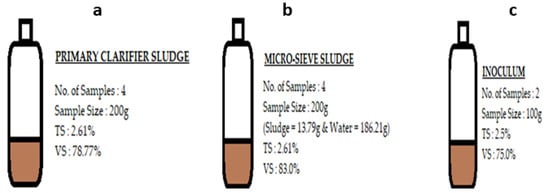
Figure 2.
(a) PC batch preparation; (b) MS batch preparation; and (c) inoculum batch preparation.
Four sets of bottles were prepared for each sludge mixture, while two sets of blank trials (bottles with inoculum–without sludge) were also carried out alongside, each time. The quantities of inoculum and substrate (mL) introduced in each vial are shown in Table 2.

Table 2.
The setup of batch reactions in vials.
Biogas production during AD was determined by measuring the pressure inside the reaction bottles, using the ideal gas law according to [11], which converts the headspace pressure to biogas volume. In detail, the bottle headspace was connected through the valve to a digital manometer (Gain Express A0182152, ±0.01 Kpa) and the pressure (P1) before AD was measured. Then, the bottle was placed in the incubator and next day (about same time) the final pressure (P2) was measured. The volume of biogas produced was calculated using Equation (2). To keep the anaerobic conditions in the reaction vial constant the release of the biogas was done using a water trap. Following the aforementioned process, the reaction vials were placed in the incubator and the process was repeated until the digestion period elapsed, which lasted for 30 days.
- Vbiogas—Volume of biogas produced daily (mL);
- Vr—Headspace volume (mL);
- P1—Headspace pressure after release of biogas (KPa);
- P2—Headspace pressure before release of biogas (KPa);
- Ta—Ambient temperature (K);
- Tr—Temperature of the reactor (K).
At the end of the 30-day digestion period the reduction of volatile solids was determined according to Equations (3)–(5).
TS (dry wt basis, g) = TS (%) ∗ Sample size (g)
VS (dry wt basis, g) = VS (%) ∗ TS (dry wt, g)
3. Results
3.1. Solids Concentration
3.1.1. Total Solids Concentration
Naked eye observations showed PC sludge to be semi-liquid in comparison to MS sludge, which was much drier and solid in nature. TS analysis indicated that the average TS concentration for PC and MS sludge was 2.61 ± 0.08% and 37.86 ± 0.08%, respectively (Figure 3).
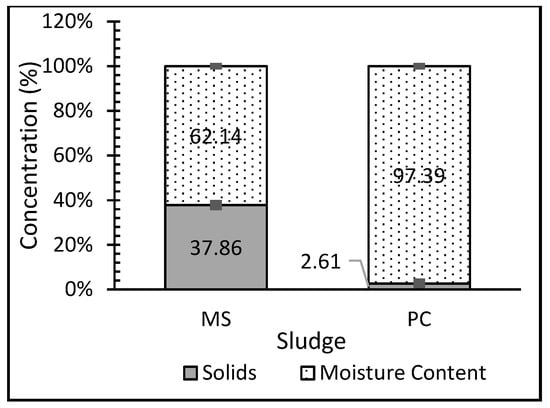
Figure 3.
The solids and moisture content of PC and MS sludge.
3.1.2. Volatile Solids Concentration
The VS content, as a fraction of TS, MS and PC sludges ranges in the same lavers, with average values of 83 ± 0.41% and 78.77 ± 1.91%, respectively (Figure 4), with the MS sludge indicating slightly higher VS content. The latter may be attributed to the nature of the sludges, as small diameter inorganic matter (relatively heavier than inorganic matter of similar size) is being selectively settled in PCs, while such particles go through the MS filter; as a result, PC sludge is expected to have slightly lower VS content. The VS/TS ratio for MS and PC sludges was calculated as 0.83 ± 0.00 and 0.79 ± 0.02, respectively.
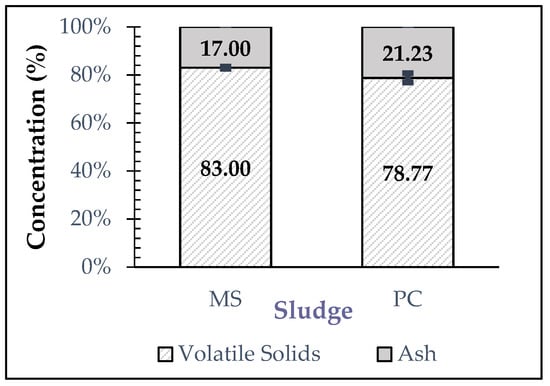
Figure 4.
The volatile solids concentration of PC and MS sludge.
3.2. Composition of Sludges
3.2.1. Carbon to Nitrogen Ratio
Elemental analysis showed that the average nitrogen, carbon and hydrogen concentrations of PC and MS sludges where 3.40 ± 0.21%, 48.95 ± 1.16% and 12.78 ± 0.49%, respectively, for PC sludge and 2.43 ± 0.21%, 47.60 ± 2.47% and 8.65 ± 0.92%, respectively, for MS sludge (Figure 5). Even if PC sludge indicated a higher concentration for all elements monitored, MS sludge exhibited a higher C/N ratio (19.68 ± 0.69), compared to PC sludge (14.46 ± 1.23). The latter suggests that although PC sludge showed a high content of nitrogen, carbon and hydrogen individually, MS sludge exhibited a better nutrient balance, an important issue for the progressing of anaerobic digestion and for biogas production.
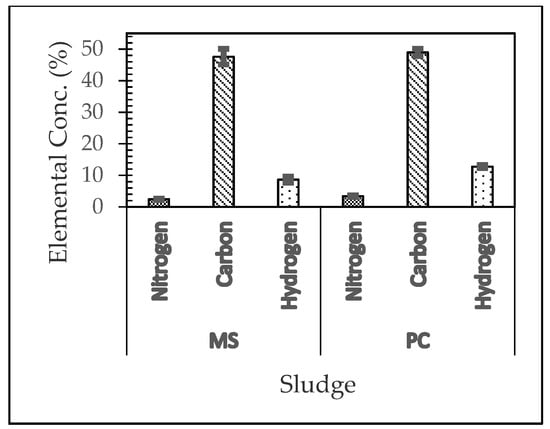
Figure 5.
Nutrient composition of MS and PC sludge.
3.2.2. Initial pH of Sludges
Although pH change over the course of AD process, it is wise to monitor the initial pH, to ensure that it lies within the desired range. PC and MS sludges indicated similar pH values, at 6.61 ± 0.10 and 6.67 ± 0.08, respectively (Figure 6). The initial pH is adequate to sustain AD.
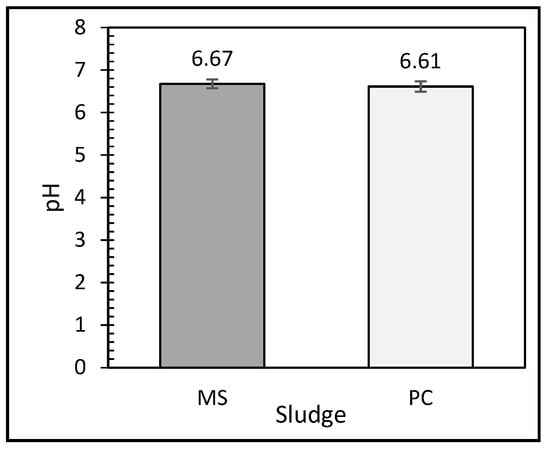
Figure 6.
pH level in both MS and PC sludge.
Figure 7a shows the daily headspace pressure prior to biogas release, for all trials, during AD. At day 1 the headspace pressure in all bottles was about 10 ± 5 KPa, with inoculum bottles scoring the lowest and PC batches scoring the highest. The headspace steadily dropped to 5 KPa for the next four days, but after the fifth day, the headspace pressure levels of PC and MS started to rise at a high rate, with the PC batches reaching their peak on day 12 recording a pressure of 27.65 ± 0.90 KPa. On the other hand, MS batches indicated a relatively lower increase rate, reaching maximum (26.16 ± 0.86 KPa), on day 14.
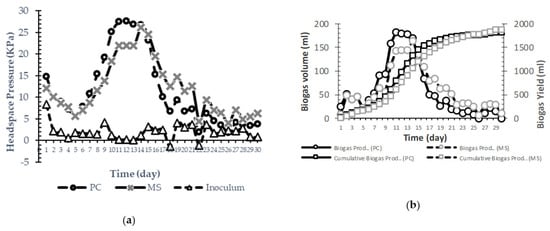
Figure 7.
(a) The daily measurements of headspace pressure of PC and MS sludge; (b) the average daily specific biogas yield and average specific cumulative biogas yield of PC and MS sludge.
3.2.3. Biogas Yield
Peak daily biogas production was reached at 11 or 14 days, since the initiation of batch AD reactions, for PC or MS sludge, respectively (Figure 7b). The maximum daily biogas production was measured as 44.20 mlbiogas/gvsd or 37.74 mlbiogas/gvs2 d, respectively, as shown in Figure 7b. However, even though PC sludge achieved earlier peak production, the cumulative production of biogas throughout the 30 days period of AD reaction was almost equal for both types of sludge (442.29 mlbiogas/gvs for PC sludge, versus 434.73 mlbiogas/gvs for MS sludge). The slightly higher cumulative biogas production for MS sludge, compared to PC sludge, with a delay in biogas production for MS sludge, indicates that MS sludge has a higher overall potential for biogas production, but due to the nature of the MS sludge it is more difficult to be digested.
Table 3 summarizes the start and ending conditions regarding TS and VS content of the AD trials for PC and MS sludges. The initial conditions have been determined following the mixing of sludge with inoculum, while for the MS sludge water had also been added.

Table 3.
Analysis of the solids concentration (SC) into and out of the reactor.
4. Discussion
4.1. Solids Concentration
4.1.1. Total Solids Concentration
The TS concentrations of MS and PC sludges determined in the present study are consistent with the ones measured in previous studies [12], lying in the ranges of 38–42% for MS and 3–6% for PC sludges. Both type of sludges has similar composition, apart from water content. The significantly higher TS concentration of MS sludge may be attributed to the unique solids separation system (rotating belt filter), combined with the dewatering auger [1]. On the contrary, PC sludge is a sedimentation product, thus the low TS concentration. However, even if the PC sludge would be processed by thickening and dewatering (belt filter press, decanter, auger) the TS solid concentration may not increase beyond about 20% [13].
4.1.2. Volatile Solids Concentration
Both types of sludges have high VS concentration, which indicates their strong capacity for biogas production through AD [14]. According to Wang et al. [15] a reliable indicator for biogas production potential, from municipal sludges, is the VS/TS ratio, which should take values above 50%, as this was the case for both sludges tested in the present study. Thus, both, types of the sludges tested may be nominated as suitable feedstock for high yield AD process.
4.2. Composition of Sludge
4.2.1. Carbon to Nitrogen Ratio
A balanced C/N ratio is wise, for smooth AD. A relatively high C/N ratios prompts towards consumption of nitrogenous compounds by methanogenic bacteria, whereas a relatively low C/N ratio may cause ammonia inhibition due to insufficient consumption of nitrogenous compounds. Therefore, in both unbalanced C/N ratios may lead to failure of the AD process and to reduced biogas yield [16]. Although the optimum C/N ratio for AD is generally in the range of 20–30 [17], such a ratio for sewage sludge usually lies in the range of 10–20 [18], which agrees with the ratios obtained in Figure 5. The need for a good balance of nutrients is, however, one of the reasons why recently a lot of focus has solely shifted towards co-digestion, since it has been recognized as playing a vital role in the optimization of AD process [19], because it enhances the balance of nutrients in the reactor, thus maximizing biogas production.
4.2.2. pH
The pH in the AD reaction vessel is an important parameter that affects the activity of all microbial communities involved in the production of biogas, with the methanogenic bacteria being particularly sensitive on pH value [20]. In the present study, the pH was measured once, right after inoculation. Previous studies have indicated that the microbial communities active during the initial AD phases, such as hydrolysis, acidogenesis and acetogenesis are quite tolerable to pH values between 5.5 to 6.5 [21], thus the initial pH levels recorded in the present study, the values of 6.61 to 6.67 shown in Figure 6 are very close to the optimum range, indicating the suitability of MS and PC sludges to function as AD substrates. On the other hand, the optimum pH for the growth of methanogenic bacteria is closer to neutral, at the range of about 6.8 to 7.6 [22], which may have affected to some extent the production of biogas in the present study. Due to the biochemical reactions during the initial stage of AD, it is likely that the pH was further shifted towards lower values, thus driving even further away from the optimum conditions of methanogenesis [23].
4.3. Biogas Production
Biogas Yield
Biogas production was calculated indirectly, by measuring the headspace pressure inside the AD bottles and by employing the ideal gas law (Equation (2)). Figure 7a depicts the pattern of overall biogas production (in terms of headspace pressure) that was observed, while Figure 7b shows the biogas produced following the subtraction of biogas emitted due to the fermentation of the inoculum.
From Figure 7b, it may be observed that during the first 5 days from inoculation, biogas production did not follow any certain pattern, which is typical during the hydrolysis phase [23,24,25]. On the other hand, a notable lag is observed in biogas production between days 5 to 14, for MS sludge, compared to that of PC sludge. Such lagging may be attributed to the relatively high content of toilet paper in raw wastewater. Toilet paper is comprised primarily of cellulose, which in the case of primary clarification undergoes partial hydrolysis (inside the clarifier), thus PC sludge is more digestible compared to MS sludge. Indeed, during the production of MS sludge, cellulosic matter is trapped on the cloth filter and within minutes is dewatered in the auger, thus keeping cellulose almost intact [5,26,27]. However, despite the observed lagging in biogas production for MS sludge, the cumulative biogas production throughout the 30 days of AD is similar for both types of sludges, as following day 14, daily biogas production from MS sludge overtakes that of PC sludge. The latter may be attributed to the fact that non-reacted cellulose in MS sludge becomes more and more available for AD.
4.4. Volatile Solids Reduction
The expected reduction of TS concentration during AD, as seen in Table 3 is due to the conversion of organic matter into biogas. The above reaction leads also to the production of water [28], which contributes to further reduction of TS concentration. Obviously, the reduction of VS fraction is due to the selective removal of organic matter, whilst inorganic materials during AD remain intact [13]. Generally, both sludges exhibited a relatively poor VS reduction (below 50%). PC sludge exhibited a higher VS reduction, compared to MS sludge (45.06% versus 32.39%).
The experimental trial for which Ri/s was 1.0 also showed that PC sludge had a higher VS reduction, compared to MS sludge (32.23% versus 22.20%). On the other hand, the third trial for which Ri/s was 2.8, MS sludge in this case exhibited a slightly higher VS reduction in comparison to PC sludge (25.91% versus 21.23%). However, both trials showed that they had an overall lower VS reduction for both sludges when compared to that which had Ri/s of 0.45, which was of particular focus for this experiment.
5. Conclusions
The present study examined the biogas production potential and the physicochemical characteristics for two types of sludges: sludge from PC and sludge from MS. The main findings are summarized below:
- The main physiochemical characteristics, for MS and PC sludges, have been determined by the present study as: TS: 37.86 ± 0.08%, 2.61 ± 0.08%, VS: 83 ± 0.41%, 78.77 ± 1.91%, pH: 6.67 ± 0.08, 6.61 ± 0.10, C/N: 19.68 ± 0.69, 14.46 ± 1.23, respectively. The most obvious difference is the significantly lower of TS content, for PC sludge.
- PC sludge reaches its peak daily biogas yield 11 days from inoculation (44.20 mlbiogas/gvsd), while MS sludge maximizes the daily biogas yield at day 14, since inoculation (37.74 mlbiogas/gvsd).
- PC sludge exhibits a higher daily biogas production during the first 14 days of AD, while from day 15 and onwards, MS sludge has higher daily biogas production, indicating that PC sludge contains higher fraction of readily biodegradable compounds.
- Both sludges have similar cumulative biogas production yield, with PC sludge slightly surpassing that of MS sludge over 30 days of AD (442.29 mlbiogas/gvs versus 434.73 mlbiogas/gvs), reflecting that they both contain similar fractions of biodegradable compounds.
- Generally, both sludges exhibited a relatively poor VS reduction (below 50%). PC sludge exhibited a higher VS reduction, compared to MS sludge (45.06%. versus 32.39%).
- All things considered, both, PC and MS sludges have exhibited similar behavior with respect to biogas production potential, with PC sludge indicating a slightly better performance. Thus, selecting the MS technology instead of PC, gives all benefits of MS (i.e., lower footprint, high solids content of sludge) without compensating on biogas production potential.
Author Contributions
The authors of this article contributed to this manuscript as follows; conceptualization, P.T.O. and P.G.; methodology, A.M.; validation, P.T.O., P.M.M. and P.G.; formal analysis, P.M.M., P.T.O., P.G.; investigation, P.M.M., A.M.; writing—original draft preparation, P.M.M.; writing—review and editing, P.T.O. and P.G.; supervision, P.T.O.; project administration, P.G.; funding acquisition, P.G., P.T.O. All authors have read and agreed to the published version of the manuscript.
Funding
This research was partially funded by the Erasmus Plus International Programme (2017-9/ΚA 107) (Contract No.: 017-1-EL01-KA107-035433), which funded the transportation and subsistence of Mr. Potlako Marumoloa to the Technical University of Crete.
Institutional Review Board Statement
Not applicable.
Informed Consent Statement
Not applicable.
Acknowledgments
This work was made possible by the generous sponsorship of the European Union (EU) through the Erasmus + program. The authors wish to thank the Technical University of Crete through the Design of Environmental Processes Laboratory, School of Chemical Engineering and Environmental Engineering, for provision of the instrumentation and regents used in the laboratory tests.
Conflicts of Interest
The authors declare no conflict of interest.
References
- Franchi, A.; Stedman, K.; Gikas, P. Enhanced primary solids removal from municipal wastewater by two steps filtration. In Proceedings of the IWA Regional Conference on Wastewater Purification and Reuse, Heraklion, Greece, 28–30 March 2012. [Google Scholar]
- Gikas, P. Commissioning of the gigantic anaerobic sludge digesters at the wastewater treatment plant of Athens. Environ. Technol. 2008, 29, 131–139. [Google Scholar] [CrossRef] [PubMed]
- Gikas, P. Towards energy positive wastewater treatment plants. J. Environ. Manag. 2017, 203, 621–629. [Google Scholar] [CrossRef]
- Siatou, A.; Manali, A.; Gikas, P. Energy Consumption and Internal Distribution in Activated Sludge Wastewater Treatment Plants of Greece. Water 2020, 12, 1204. [Google Scholar] [CrossRef]
- Ghasimi, D.S.M.; de Kreuk, M.; Maeng, S.K.; Zandvoort, M.H.; van Lier, J.B. High-rate thermophilic bio-methanation of the fine sieved fraction from Dutch municipal raw sewage: Cost-effective potentials for on-site energy recovery. Appl. Energy 2016, 165, 569–582. [Google Scholar] [CrossRef] [Green Version]
- Kalderis, D.; Aivalioti, M.; Gidarakos, E. Options for sustainable sewage sludge management in small wastewater treatment plants on islands: The case of Crete. Desalination 2010, 260, 211–217. [Google Scholar] [CrossRef]
- Lema, J.M.; Suarez, S. Innovative Wastewater Treatment & Resource Recovery Technologies: Impacts on Energy, Economy and Environment; IWA Publishing: London, UK, 2017; ISBN 9781780407876. [Google Scholar]
- World Health Organization. World Health Statistics 2018: Monitoring Health for the SDGs, Sustainable Development Goals. Geneva. Available online: who.int/gho/publications/world_health_statistics/2018/en/ (accessed on 19 August 2019).
- Odirile, P.T.; Thukwi, I.; Dintwa, O.; Mbongwe, B. Faecal Sludge Management in Botswana: A Review of Current Practices and Policies Using the Case of Gaborone Low Income Areas. J. Environ. Prot. 2018, 9, 122–139. [Google Scholar] [CrossRef] [Green Version]
- Agrafioti, E.; Diamadopoulos, E. A strategic plan for reuse of treated municipal wastewater for crop irrigation on the Island of Crete. Agric. Water Manag. 2012, 105, 57–64. [Google Scholar] [CrossRef]
- Zhu, B.; Gikas, P.; Zhang, R.; Lord, J.; Jenkins, B.; Li, X. Characteristics and biogas production potential of municipal solid wastes pretreated with a rotary drum reactor. Bioresour. Technol. 2009, 100, 1122–1129. [Google Scholar] [CrossRef] [PubMed]
- Koliopoulos, G.; Sklivaniotis, M.; Gikas, P. Fine mesh sieving of raw municipal wastewater for TSS and COD removal. In Proceedings of the 13th International Conference on Environmental Science and Technology, Athens, Greece, 5–7 September 2013; Available online: http://cest2013.gnest.org/sites/all/files/program_cest2013_draft.pdf (accessed on 7 November 2018).
- Metcalf & Eddy. Wastewater Engineering: Treatment and Reuse, 4th ed.; McGraw-Hill: New York, NY, USA, 2003. [Google Scholar]
- Orhorhoro, E.K.; Ebunilo, P.O.; Sadjere, G.E. Experimental determination of effect of total solid (TS) and volatile solid (VS) on biogas yield. Am. J. Mod. Energy 2017, 3, 131–135. Available online: http://www.sciencepublishinggroup.com/j/ajme (accessed on 22 August 2019). [CrossRef] [Green Version]
- Wang, X.; Duan, X.; Chen, J.; Fang, K.; Feng, L.; Yan, Y.; Zhou, Q. Enhancing anaerobic digestion of waste activated sludge by pretreatment: Effect of volatile to total solids. Environ. Technol. 2016, 37, 1520–1529. [Google Scholar] [CrossRef] [PubMed]
- Zupančič, G.D.; Grilc, V. Anaerobic treatment and biogas production from organic waste. In Management of Organic Waste; Kumar, S., Bharti, A., Eds.; IntechOpen: London, UK, 2012. [Google Scholar] [CrossRef]
- Das, A.; Mondal, C. Biogas production from co-digestion of substrates: A review. Int. Res. J. Environ. Sci. 2016, 5, 49–57. [Google Scholar]
- Parvaresh, A.; Shahmansouri, M.R.; Alidadi, H. Determination of carbon/nitrogen ratio and heavy metals in bulking agents used for sewage composting. Iran. J. Public Health 2004, 33, 20–23. Available online: http://ijph.tums.ac.ir/index.php/ijph/article/view/1911 (accessed on 30 July 2019).
- Li, C. Wet and Dry Anaerobic Digestion of Biowaste and of Co-Substrates. Doctoral Dissertation, Karlsruhe Institution of Technology, Karlsruhe, Germany, 2015. [Google Scholar] [CrossRef]
- Mosey, F.E.; Fernandes, X.A. Patterns of Hydrogen in Biogas from the Anaerobic Digestion of Milk-Sugars. Water Sci. Technol. 1989, 21, 187–196. [Google Scholar] [CrossRef]
- Jha, A.K.; Li, J.; Nies, L.; Zhang, L. Research advances in dry anaerobic digestion process of solid organic wastes. Afr. J. Biotechnol. 2011, 10, 14242–14253. [Google Scholar] [CrossRef]
- Arshad, A.; Hashmi, H.N.; Qureashi, I.A. Anaerobic Digestion of CHL Orphenolic Wastes. Int. J. Environ. Res. 2011, 5, 149–158. [Google Scholar]
- Gerardi, M.H. The Microbiology of Anaerobic Digesters; John Wiley & Sons: Hoboken, NJ, USA, 2003. [Google Scholar] [CrossRef]
- Demirel, B.; Scherer, P. The roles of acetotrophic and hydrogenotrophic methanogens during anaerobic conversion of biomass to methane: A review. Rev. Environ. Sci. Bio/Technol. 2008, 7, 173–190. [Google Scholar] [CrossRef]
- Meegoda, J.N.; Li, B.; Patel, K.; Wang, L.B. A review of the processes, parameters, and optimization of anaerobic digestion. Int. J. Environ. Res. Public Health 2018, 15, 2224. [Google Scholar] [CrossRef] [Green Version]
- Ghasimi, D.S.M.; Tao, Y.; de Kreuk, M.; Abbas, B.; Zandvoort, M.H.; van Lier, J.B. Digester performance and microbial community changes in thermophilic and mesophilic sequencing batch reactors fed with the fine sieved fraction of municipal sewage. Water Res. 2015, 87, 483–493. [Google Scholar] [CrossRef] [PubMed]
- Ruiken, C.J.; Breuer, G.; Klaversma, E.; Santiago, T.; van Loosdrecht, M.C.M. Sieving wastewater—Cellulose recovery, economic and energy evaluation. Water Res. 2013, 47, 43–48. [Google Scholar] [CrossRef] [PubMed]
- Pantawong, R.; Chuanchai, A.; Thipbunrat, P.; Unpaprom, Y.; Ramaraj, R. Experimental investigation of biogas production from water lettuce, Pistia stratiotes L. Emergent Life Sci. Res. 2015, 1, 41–46. Available online: https://www.emergentresearch.org/uploads/38/1784_pdf (accessed on 30 July 2019).
Publisher’s Note: MDPI stays neutral with regard to jurisdictional claims in published maps and institutional affiliations. |
© 2021 by the authors. Licensee MDPI, Basel, Switzerland. This article is an open access article distributed under the terms and conditions of the Creative Commons Attribution (CC BY) license (https://creativecommons.org/licenses/by/4.0/).